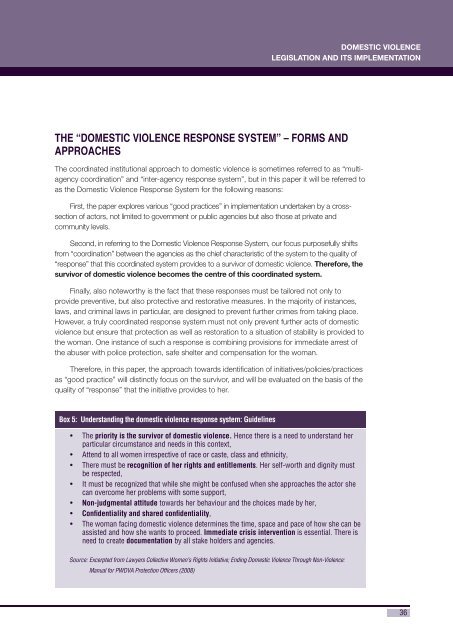Domestic Violence Legislation and its Implementation
Domestic Violence Legislation and its Implementation
Domestic Violence Legislation and its Implementation
Create successful ePaper yourself
Turn your PDF publications into a flip-book with our unique Google optimized e-Paper software.
Box 5: Underst<strong>and</strong>ing the domestic violence response system: Guidelines<br />
DOMESTIC VIOLENCE<br />
LEGISLATION AND ITS IMPLEMENTATION<br />
THE “DOMESTIC VIOLENCE RESPONSE SYSTEM” – FORMS AND<br />
APPROACHES<br />
The coordinated institutional approach to domestic violence is sometimes referred to as “multiagency<br />
coordination” <strong>and</strong> “inter-agency response system”, but in this paper it will be referred to<br />
as the <strong>Domestic</strong> <strong>Violence</strong> Response System for the following reasons:<br />
First, the paper explores various “good practices” in implementation undertaken by a crosssection<br />
of actors, not limited to government or public agencies but also those at private <strong>and</strong><br />
community levels.<br />
Second, in referring to the <strong>Domestic</strong> <strong>Violence</strong> Response System, our focus purposefully shifts<br />
from “coordination” between the agencies as the chief characteristic of the system to the quality of<br />
“response” that this coordinated system provides to a survivor of domestic violence. Therefore, the<br />
survivor of domestic violence becomes the centre of this coordinated system.<br />
Finally, also noteworthy is the fact that these responses must be tailored not only to<br />
provide preventive, but also protective <strong>and</strong> restorative measures. In the majority of instances,<br />
laws, <strong>and</strong> criminal laws in particular, are designed to prevent further crimes from taking place.<br />
However, a truly coordinated response system must not only prevent further acts of domestic<br />
violence but ensure that protection as well as restoration to a situation of stability is provided to<br />
the woman. One instance of such a response is combining provisions for immediate arrest of<br />
the abuser with police protection, safe shelter <strong>and</strong> compensation for the woman.<br />
Therefore, in this paper, the approach towards identifi cation of initiatives/policies/practices<br />
as “good practice” will distinctly focus on the survivor, <strong>and</strong> will be evaluated on the basis of the<br />
quality of “response” that the initiative provides to her.<br />
• The priority is the survivor of domestic violence. Hence there is a need to underst<strong>and</strong> her<br />
particular circumstance <strong>and</strong> needs in this context,<br />
• Attend to all women irrespective of race or caste, class <strong>and</strong> ethnicity,<br />
• There must be recognition of her rights <strong>and</strong> entitlements. Her self-worth <strong>and</strong> dignity must<br />
be respected,<br />
• It must be recognized that while she might be confused when she approaches the actor she<br />
can overcome her problems with some support,<br />
• Non-judgmental attitude towards her behaviour <strong>and</strong> the choices made by her,<br />
• Confi dentiality <strong>and</strong> shared confi dentiality,<br />
• The woman facing domestic violence determines the time, space <strong>and</strong> pace of how she can be<br />
assisted <strong>and</strong> how she wants to proceed. Immediate crisis intervention is essential. There is<br />
need to create documentation by all stake holders <strong>and</strong> agencies.<br />
Source: Excerpted from Lawyers Collective Women’s Rights Initiative; Ending <strong>Domestic</strong> <strong>Violence</strong> Through Non-<strong>Violence</strong>:<br />
Manual for PWDVA Protection Offi cers (2008)<br />
36

















